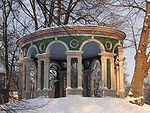Haga Palace

Haga Palace (Swedish: Haga slott), formerly known as the Queen's Pavilion (Swedish: Drottningens paviljong), is located in the Haga Park, Solna Municipality in Metropolitan Stockholm, Sweden. The palace, built between 1802 – 1805, was modelled after ballet-master Gallodiers Italian villa in Drottningholm by architect Carl Christoffer Gjörwell on appointment by King Gustaf IV Adolf for the royal children. It has been the home or summerhouse for several members of the Swedish royal family – most notably it was the birthplace of the present King – until 1966 when King Gustaf VI Adolf transferred its disposal to the government and it was turned into a guesthouse for distinguished foreign official visitors. In 2009, it was announced by Prime Minister Fredrik Reinfeldt that the rights of disposal to the palace would be transferred back to the royal court to be used by Victoria, Crown Princess of Sweden and her husband, Prince Daniel, Duke of Västergötland, as a wedding gift in 2010. They moved into Haga Palace after their wedding on 19 June that year.
Excerpt from the Wikipedia article Haga Palace (License: CC BY-SA 3.0, Authors, Images).Haga Palace
Gustafsborgsvägen, Stockholm Norra Djurgården (Östermalms stadsdelsområde)
Geographical coordinates (GPS) Address Website External links Nearby Places Show on map
Geographical coordinates (GPS)
| Latitude | Longitude |
|---|---|
| N 59.363611111111 ° | E 18.039444444444 ° |
Address
Haga slott
Gustafsborgsvägen
114 18 Stockholm, Norra Djurgården (Östermalms stadsdelsområde)
Sweden
Open on Google Maps










